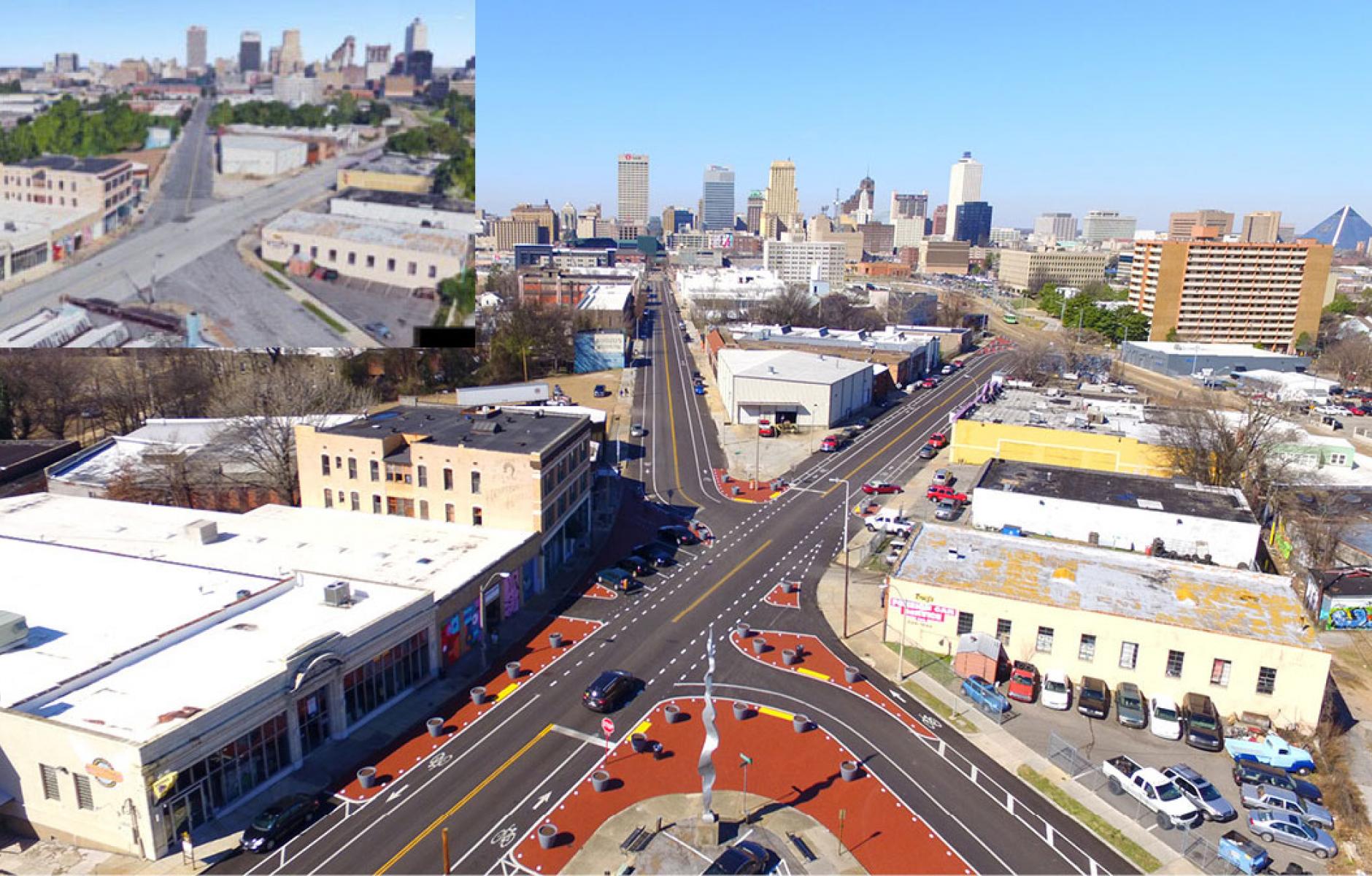
Healing a troubled medical district
At 2.6 square miles, the Memphis Medical District is a city-within-a-city that has suffered severe disinvestment in the last 50 years. The population, once more than 30,000, declined to less than 10,000 by 2014, when medical and educational institutions in the district agreed to partner with local philanthropy to create the Memphis Medical District Collaborative (MMDC).
Adjacent to downtown, the district has a rich cultural history and is the home of iconic buildings like Sun Studios, the Memphis Cycle Shop, and the historic Wonder Bread Factory, recently renovated.
The eight anchor institutions— Baptist College of Health Sciences; Memphis Bioworks Foundation; Methodist Le Bonheur Healthcare; Regional One Health; Southern College of Optometry; Southwest Tennessee Community College; St. Jude Children’s Research Hospital/ALSAC; University of Tennessee Health Science Center—employ more than 20,000 people, and jobs have been growing.
Ninety-four percent of the employees commute alone by car, according to a recent report—an astonishing figure for a area that is so close to downtown. Forty-six percent of district residents live below the poverty line, and very few residents work at the anchor institutions.
The public-private partnership is addressing many issues simultaneously, including the economy, safety, housing, employment, and social life of the district. The MMDC approach is informed by New Urbanism theory and practice. The organization is facilitating the development of new affordable and mixed-income housing within a framework of streets that are being made walkable again. It is promoting social life through community programs in human-scale public spaces and supporting job-creation in mixed-use neighborhoods.
MMDC addresses much more than urbanism, but urbanism sets the foundation for a broad vision. Streetscape improvements and new public spaces build momentum and enthusiasm for other programs that require more time and resources, according to a recent report by Democracy Collaborative and Innovate Memphis. “I really think what they have done with the streetscapes has probably yielded the most change in the neighborhood,” notes one planning partner. A common theme that emerged from stakeholder interviews was the value of quick and tangible changes, the report states—especially placemaking, public art, storefront activation, and neighborhood events.
MMDC employs an “anchor strategy” for redevelopment. The Memphis-based Hyde Family Foundation looked to Midtown Detroit, the home of Wayne State University and Children’s Hospital of Michigan, for inspiration on how a similar approach could work in Memphis. As a result, MMDC was created in 2016.
The entire area is in a Opportunity Zone, which is the largest federal community development program in decades. The program allows for place-based capital gains tax cuts in qualified zones, like the low-income area that includes the Memphis Medical District.
Need for public realm improvements
Although the district is very urban, with well-connected blocks and streets, much of the urban environment is automobile-oriented visually and functionally. An overabundance of surface parking, gates, drive-throughs, and fences mar the streets. The district’s 270 acres of commercial and institutional parking exert a major impact on the area, as do two Interstates, 40 and 69, that traverse the district. The collaborative seeks to make the neighborhoods around the anchor institutions more livable, vibrant, and safe.
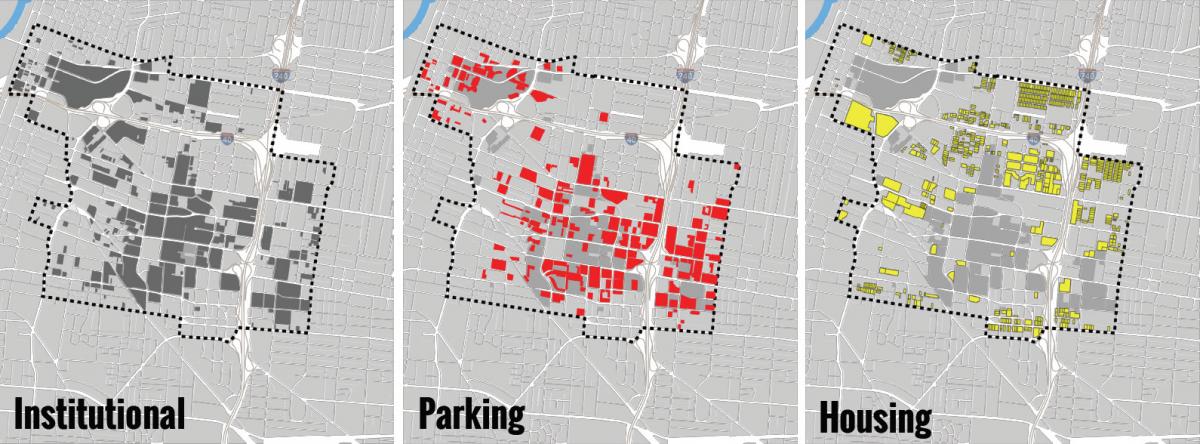
The overabundance of parking is related to the high percentage of anchor-institution employees who drive alone each day. MMDC has a goal of reducing that number by 10 percent in 10 years. Transportation demand management strategies have the potential to reduce the need for parking and shift commuting mode share.
As demand drops for parking, some of the land can be put to more productive use. A mixed-use development by the Southern College of Optometry (SCO) is part of that effort. Janice Frazier-Scott with SCO credits MMDC with inspiring the idea. “The fact that we are considering providing housing, that’s something we never would have considered.”
MMDC’s programs are organized into three broad areas: Place-based programs, anchor programs, and real estate services.
Place-based programs
The place-based programs are focused on public spaces, events and programming, clean and safe streets, community engagement, and community and economic development.
MMDC completed 19 placemaking interventions in the district, including nine public art installations in collaboration with local arts organizations, neighborhood associations, and other public-private partners. New public spaces have been created. Blocks and streets are often irregular, resulting in odd-shaped parcels—like the Edge Triangle that was redeveloped as a landscaped park. The community was heavily involved in the design and the land was prepared for parkland by volunteer labor. An off-leash dog area was included in the space. In September of 2017, the first “yappy hour” was organized, where residents come together and enjoy drinks and allow dogs to roam.
MMDC has undertaken 13 streetscape improvements (see photos at top of article). These improve the appearance of the public realm while addressing safety by calming traffic and making intersections easier to cross. Given that conventional streetscape changes often take cities five or 10 years to implement, the collaborative’s achievement is remarkable—and is made possible through a partnership with the city. MMDC first created a “medical district streetscape playbook” in 2016, which identified 35-50 interventions that would upgrade the streets throughout the district.
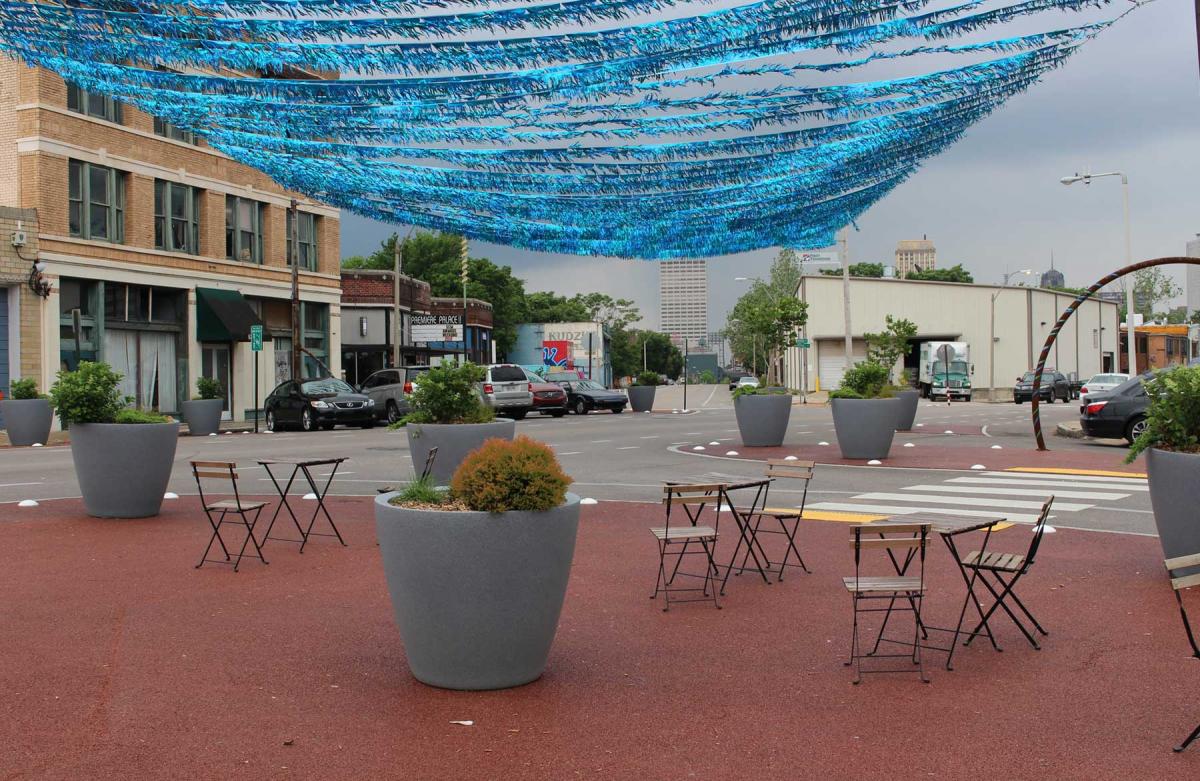
MMDC works with the city’s repaving schedule and pays for the engineering of a streetscape change. The city pays for the repaving and striping, using MMDC’s design work (by local engineering and planning firm Alta Design). The Collaborative installs the street furniture, plantings, and other enhancements. The district opts for a “bolt down” rather than a “poured concrete” approach to the changes—aiming for improvements that could last about a decade. “The traditional approach might be a million-dollar fix for an intersection,” says Tommy Pacello, president of MMDC. “We don’t have that kind of money, so we are looking at the $100,000-$150,000 fix” (with design and engineering, the costs are generally $200,000 or more). For the “poured concrete” approach, often including changes to the curbs, cooperation may be required at the local, state, and federal levels—and stormwater issues come into play—delaying the project for years.
The MMDC strategy is simpler, more agile, and can be adjusted if street users change significantly in coming years. “Who would’ve foreseen the popularity of scooters, for example,” Pacello says. The “bolt down” method uses self-watering planters, bollards, StreetBond, epoxy gravel and other materials that are more durable and effective than paint—yet they save money and time compared to conventional public works projects. Mike Lydon and Tony Garcia of Street Plans Collaborative, who have promoted this strategy in cities across the US, have advised the organization.
MMDC has issued 38 grants of up to $5,000 to businesses, developers, or people with ideas for the district to turn those concepts into marketable projects. Much of the funds go toward redesign of storefronts and buildings. “More than 40 percent result in actual projects or business improvements,” Pacello says. “The results get people talking about their projects and this generates positive publicity.” Local businesses are empowered to freshen up tired-looking main street buildings, adding to the impact of public realm enhancements.
“MMDC’s wide-ranging role in supporting business development can be seen in the consulting services and investments provided to Edge Alley, the new café and coffee-roaster that opened July 2017 with micro-retail incubator space for four entrepreneurs,” report Democracy Collaborative and Innovate Memphis. Edge Alley has since expanded its business and only one of micro-retailer space remains.
Ten people have been hired as “District Ambassadors” who move throughout the district daily, engaging with residents and employees, maintaining landscaping, picking up trash and recyclables, and removing graffiti. MMDC also has sponsored more than 100 individual events and seven event series—including bike rides, concerts, food truck rodeos, films, and the aforementioned “yappy hour.”
Anchor programs
The anchor programs capture the value of the anchor institutions—and they fall under the headings Buy Local, Hire Local, and Live Local.
Buy Local is a procurement strategy designed to boost spending in the city. The total procurement of the anchor institutions is $1.2 billion annually, including $336 million total in information technology, construction, staffing, and office supplies. These categories represent a significant opportunity for more local spending. From 2014 to 2018 local spending has risen $22.4 million (68 percent) and spending with local minority- and women-owned businesses has increased $8.5 million (180 percent). Overall spending increased by $105 Million (39 percent). “In both cases we were able to outpace overall growth in spending,” Pacello says. “We still have a long way to go.”
The medical institutions have committed to hire 100 local residents under the Hire Local initiative. MMDC is working with local workforce training and development partners to connect neighborhood residents to jobs at the anchor institutions. A shallow pool of local talent is a barrier—hence the need for training.
Live Local deals most directly with urbanism and has the potential to transform the area in the long term. In 2014, only 2.7 percent of anchor institution workers, and 6 percent of off-campus students, lived in the district. MMDC created incentive programs to live in the district. Since December 2016, when Live Local launched, more than 130 program participants either moved to the district or re-signed their leases. Yet the limited quality housing stock in the district is a barrier to higher participation in the program. The organization is employing multiple real-estate development strategies to boost housing supply.
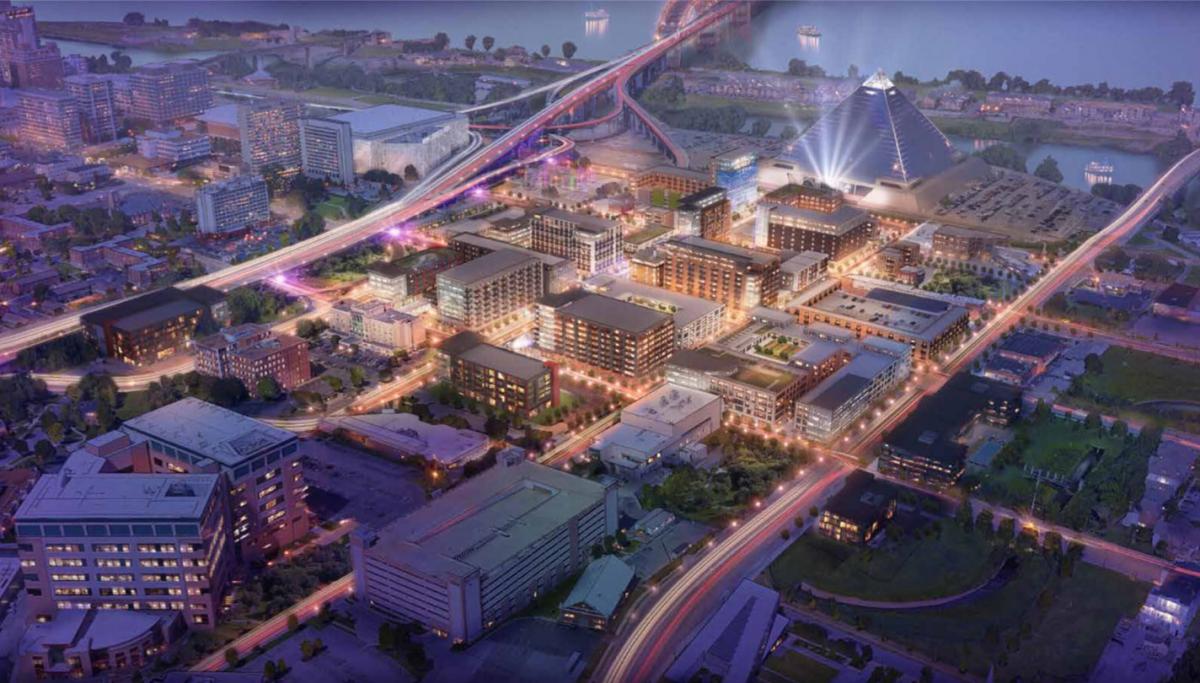
That brings us to real estate services, the third broad category, which are focused on development in the district that will enhance livability in the neighborhoods adjacent to the institutions. Services include technical assistance, pre-development support, targeted acquisition, connection to capital, and partner coordination.
Building incrementally
In the North Poplar neighborhood, MMDC has partnered with a master developer, Artifex, consisting of Will Bergin, John Anderson, Bruce Tolar, and David Kim—all new urbanists and Incremental Development Alliance (IncDev) members. The partnership also includes builders who plan to construct 64 units of workforce housing on 25 scattered-site parcels totaling 3.4 acres. These consists of small-lot single family, duplex, quadraplex, cottage court, and live-work units. MMDC is providing pre-development support to the team, including equity investments and connections to capital. All units will be affordable to households making 80 percent of the area median income. The affordable housing will be subsidized to the tune of $22,000 per unit. The low cost of the land in this neighborhood is an advantage.
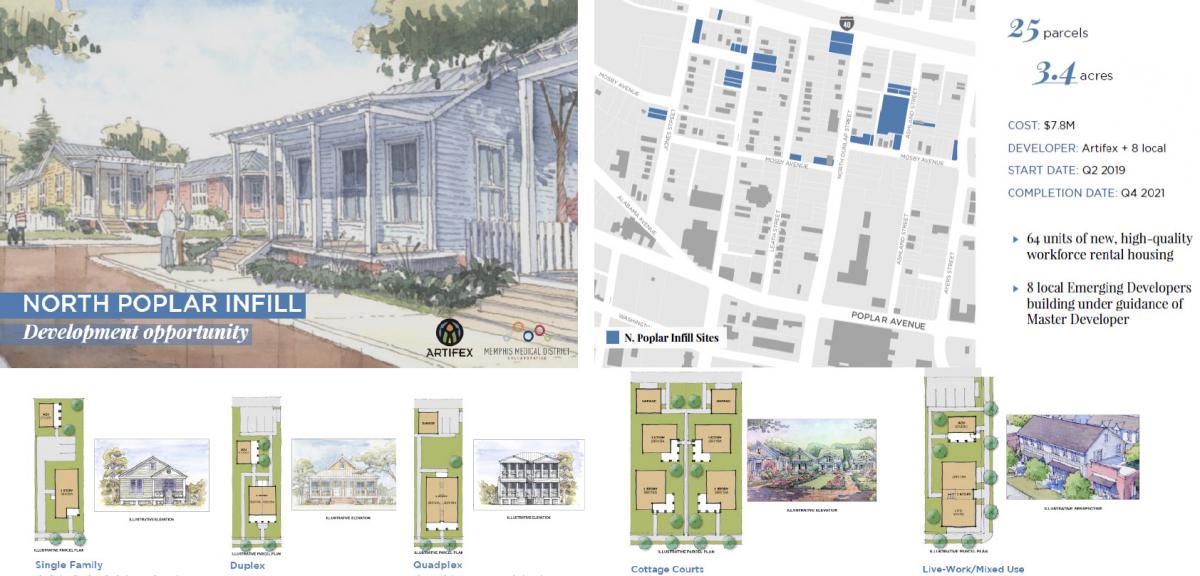
Emerging developer workshops and bootcamps have trained 200 local people—half minority and more than a third female—on how to gain financing and begin the process of becoming a small developer. The bootcamps have been sponsored in partnership with the city, Kresge Foundation, Downtown Memphis Commission, BLDG Memphis, Neighborhood Preservation Inc., ULI, MMDC and IncDev, which conducted the training. The North Poplar project is scheduled to begin in the fall of 2019.
MMDC is providing support for other development. The Edge Neighborhood, just east of downtown, is one focal point. The Memphis Cycle Shop building was originally part of Auto-Row in Memphis—an area with large format buildings with elegant storefronts. The 28,000-square-foot building, originally an auto dealership and then serving a variety of purposes, is planned for restoration, including all of the original storefront glazing—for use as retail, office, and a café. The collaborative assisted with concept development and tenant recruitment.
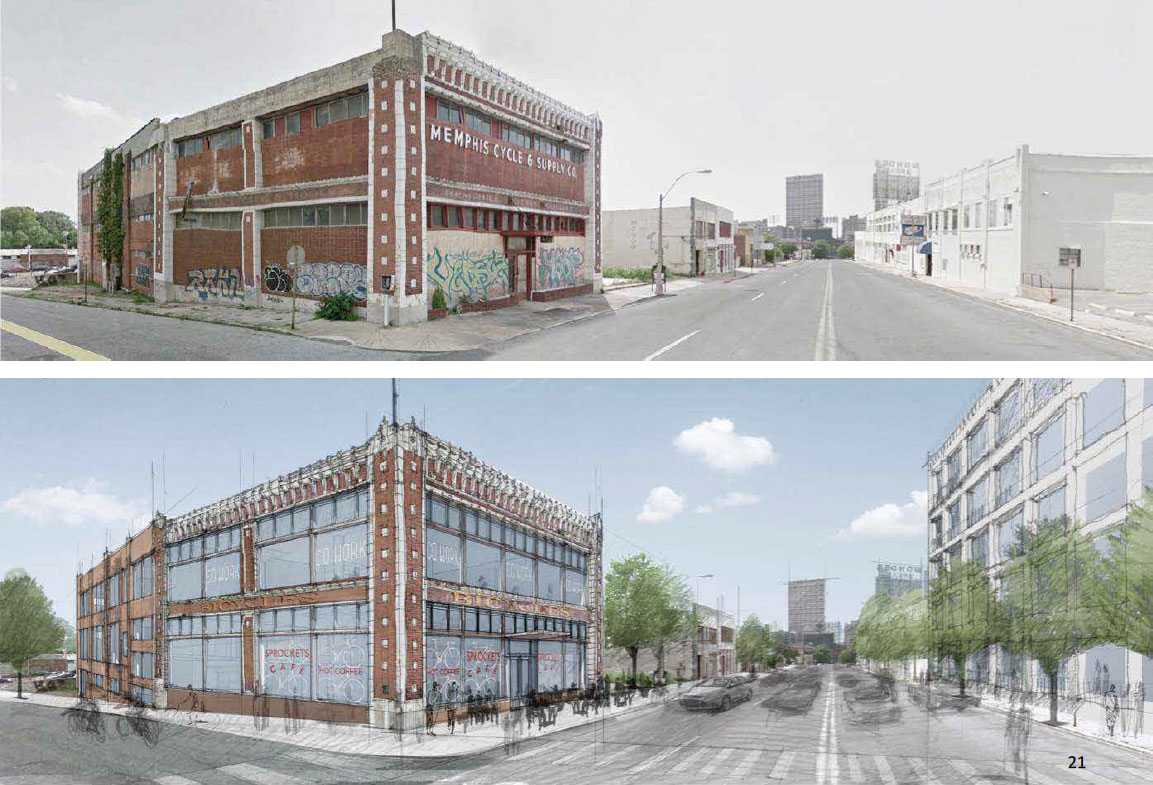
The aforementioned SCO mixed-use project will create 110 living spaces for graduate students and market-rate renters. This project is slated for completion in 2021, to coincide with the opening of classes. The MMDC provided coordination, support, and technical assistance.
In parts of the district, development is happening independent of MMDC. The Pinch District, a nine-plus block part of the Medical district adjacent to St. Jude’s and downtown, is the locus of substantial investment in accordance with a plan by the City and Looney Ricks Kiss (LRK), the Memphis-based new urban architecture/urban design firm. MMDC recently put out a national request for proposals to develop two blocks in The Pinch District, so the collaborative is getting involved here as well.
The organization is in the process of raising $2.5 million for a revolving real estate capital fund. The MMDC is also working with local and national philanthropy to create a $25-30 million fund to support mixed-use, mixed-income developments in the district.
The Memphis Medical District combines all of the issues that the Congress for the New Urbanism has long studied through its Health Districts project—whereby health institutions seek to improve the health and well-being of employees, patients, visitors, and neighbors. It also incorporates many of the strategies highlighted in CNU’s recent Building Local Strength report, which focuses on bringing investment to low-income areas in ways that are sensitive to the threat of displacement and emphasize access to opportunity.
“Medical and educational institutions want lovable places that are walkable and vibrant. Their employees are not just doctors and researchers—they also include people making $15 an hour,” Pacello notes. “The full spectrum of employees and students need options to live close by and get around in many ways, and they need more active public spaces and healthier food options than big box stores and fast food restaurants. All of this translates to our work.”
MMDC has advised the medical/educational institutions on best practices for urban design of their own facilities, but Pacello cautions that this approach will only have an impact over many decades. Designing facilities falls under the category of “mission critical” work for the institutions. MMDC has more immediate impact with what Pacello calls “mission aligned” work, including making the surrounding neighborhoods more livable and leveraging the economic power of the institutions and their employees.
The current comprehensive approach is 20 years in the making. An excellent new urbanist land-use vision was created for the district in the early 2000s by LRK, followed by a form-based code overlay. Very little progress was made until recent years, when the anchor institutions organized—creating the MMDC with its $4 million annual budget. If someone had recommended such a budget at the start, the suggestion likely would have been poorly received, Pacello believes.
The “anchor strategy,” using Midtown Detroit as a model, has strongly influenced the work in Memphis. U3 Advisors, a real estate and economic development consultant for anchor institutions, were the conceptual architects—along with philanthropic organizations—of MMDC (Pacello was employed by U3 Advisors for a year).
One lesson for new urbanists is that “design is not enough, especially in legacy places that have suffered decades of trauma,” Pacello explains. Institutions can have a substantial economic impact on their surrounding neighborhoods if they try—but sometimes this leads to higher levels of displacement. For that reason, MMDC takes “a slower approach that is more deliberate with regards to community wealth building and inclusive development,” he says.
The new urbanist approach plays a key role in the Memphis Medical District in that public realm improvements can be implemented relatively quickly, keeping the momentum going for an economic transformation without too much disruption and shock to existing residents. New public spaces and streetscape improvements are particularly effective—as are initiatives like storefront revitalizations. All give an immediate sense that the medical district, so long disinvested, is now on the rise.
Pacello has advised other cities with institutional districts, including New Orleans, Asheville North Carolina, and Fayetteville Arkansas, on the work being done in Memphis. For more information on MMDC, send them an email.
Note: For more on CNU's recent contribution to the conversation of identifying and implementing strategies that can help revitalize communities that have seen decades of disinvestment, in ways that are sensitive to the threat of displacement and emphasize access to opportunity, see our report Building Local Strength.




